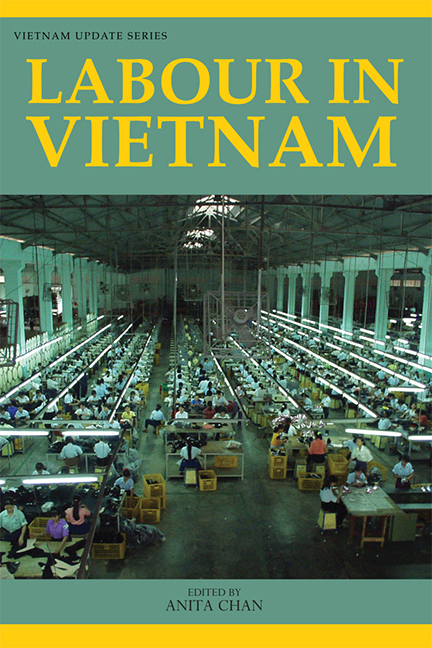Book contents
- Frontmatter
- Contents
- List of Tables and Figures
- Abbreviations
- Acknowledgements
- The Contributors
- 1 Introduction
- 2 “Awakening the Conscience of the Masses”: The Vietnamese Confederation of Labour 1947–75
- 3 State Enterprise Workers: “Masters” or “Commodities”?
- 4 The Redivision of Labour in a Red River Delta Village in a Globalized Economy
- 5 Corporate Social Responsibility in Socialist Vietnam: Implementation, Challenges, and Local Solutions
- 6 Workers' Protests in Contemporary Vietnam
- 7 Strikes in Vietnam and China in Taiwanese-owned Factories: Diverging Industrial Relations Patterns
- 8 The Dynamics of a Multinational Factory Regime and Recent Strikes in Vietnam
- 9 How Does Enterprise Ownership Matter? Labour Conditions in Fashion and Footwear Factories in Southern Vietnam
- 10 Exploitative Recruitment Processes and Working Conditions of Vietnamese Migrant Workers in Taiwan
- Index
5 - Corporate Social Responsibility in Socialist Vietnam: Implementation, Challenges, and Local Solutions
Published online by Cambridge University Press: 21 October 2015
- Frontmatter
- Contents
- List of Tables and Figures
- Abbreviations
- Acknowledgements
- The Contributors
- 1 Introduction
- 2 “Awakening the Conscience of the Masses”: The Vietnamese Confederation of Labour 1947–75
- 3 State Enterprise Workers: “Masters” or “Commodities”?
- 4 The Redivision of Labour in a Red River Delta Village in a Globalized Economy
- 5 Corporate Social Responsibility in Socialist Vietnam: Implementation, Challenges, and Local Solutions
- 6 Workers' Protests in Contemporary Vietnam
- 7 Strikes in Vietnam and China in Taiwanese-owned Factories: Diverging Industrial Relations Patterns
- 8 The Dynamics of a Multinational Factory Regime and Recent Strikes in Vietnam
- 9 How Does Enterprise Ownership Matter? Labour Conditions in Fashion and Footwear Factories in Southern Vietnam
- 10 Exploitative Recruitment Processes and Working Conditions of Vietnamese Migrant Workers in Taiwan
- Index
Summary
More than thirteen years have passed since the 1996 media exposé of the sweatshop working conditions endured by Honduran workers assembling clothes for Kathie Lee Gifford's brand led to federal-level investigations of sweatshop abuses in the United States, as well as elsewhere around the world. This media exposure prompted non-governmental organizations (NGOs) and ethical consumers to criticize brand name corporate buyers more aggressively, giving rise to the need for social reporting of working conditions. The ensuing Corporate Social Responsibility (CSR) initiatives in turn have led to a proliferation of codes of conduct (CoCs) and monitoring schemes to help inform consumers on whether the goods that they buy have been produced under exploitative conditions. There are also, of course, many CSR-like initiatives dating back to the 1970s, which include philanthropy and ethical investment. This chapter focuses on labour standards compliance, the problems in implementing them, and their effects on workers on the factory floor.
The CSR initiative gained further legitimacy at the World Economic Forum in Davos in January 1999, when UN Secretary-General Kofi Annan urged multinational corporations (MNCs) to voluntarily incorporate the nine principles established by Global Compact, a UN body established by Annan himself to set standards on human rights, labour, and the environment for the international business community. These initiatives focus attention on the global manufacturing supply chain's multi-level subcontracting practices and the resulting difficulty of monitoring labour standards at subcontractors' production sites in the developing world.
This chapter examines what the introduction of CSR to Vietnam in 2000 meant for the global supply chain and the actions and interactions of the stakeholders. By stakeholders, I mean those who have a stake in their interests, rights, and entitlements in the CSR context. From the Vietnamese side they include workers, The Vietnam General Confederation of Labour (VGCL), the labour press, the Ministry of Labour, Invalids and Social Affairs (MOLISA), local state officials, and the Vietnamese Chamber of Commerce and Industry (VCCI). The global actors include institutions such as the World Bank, the International Labour Organization (ILO), MNCs, international NGOs, and foreign subcontractors.
- Type
- Chapter
- Information
- Labour in Vietnam , pp. 119 - 159Publisher: ISEAS–Yusof Ishak InstitutePrint publication year: 2011

